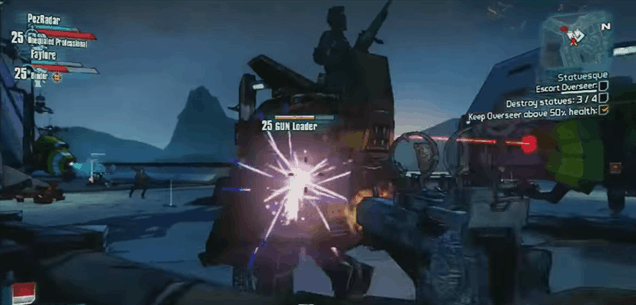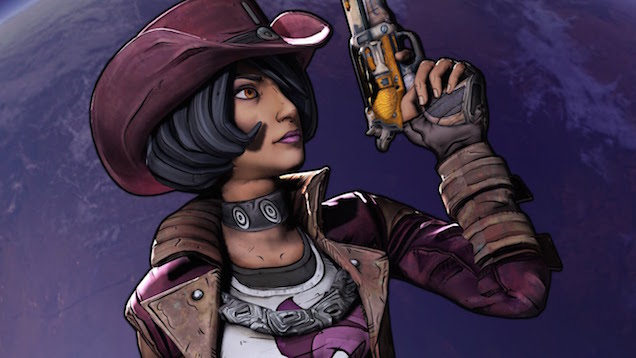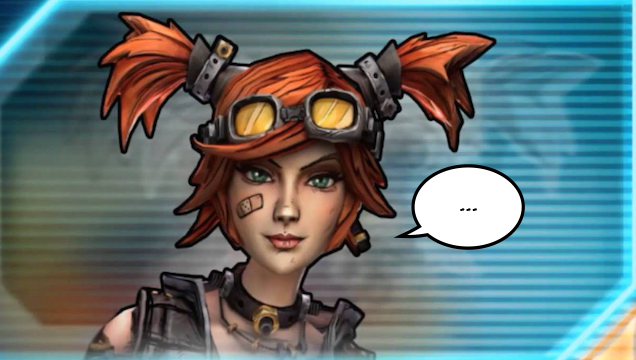I liked the first Borderlands because its protagonists didn’t really have much to say. I used to think that silent protagonists made for better video game stories. Then I wrote my own Borderlands game, listened to a lot of player feedback, and changed my mind.
The characters in the first Borderlands had some fun battle dialog, but it existed primarily to reinforce things the player already felt. You got a headshot, Mordecai shouted “BOOM”, and you kind of chuckled because, yes. Boom, indeed.
This kind of characterisation works, in theory, because if your character never says anything you (the player) disagree with, you’re more “immersed.” You’re not at risk of your protagonist saying something that you personally disagree with. Far Cry 3‘s Jason Brody might really care about saving his friends, but all you want to do is stab a bear and craft a wallet. Contrast this with the protagonist of Far Cry 2, who remains utterly silent as the plot grows more and more horrifying. Through the hero’s silence, you get to decide if you find the violence disgusting or exhilarating.
This minimalist style of characterisation worked for Half-Life, it worked for BioShock, and, even though your characters only kind-of-sort-of talked in Borderlands (they never commented on the plot), it worked there too. So when I was tasked to help write Borderlands 2, there wasn’t even a question in any of our minds — just do what we did last time. I personally preferred silent protagonists to talkative ones, but that’s only because, you know, I was smart and everyone who disagreed was stupid.
Two years later, creative director Paul Hellquist and I sat down with a focus group and listened to them spend roughly forty-five minutes talking about how bullshit our main characters were.
It wasn’t because their action skills weren’t fun (they were) or because the story wasn’t functional (it more or less was). These focus testers were irritated because, in a game full of colourful characters and gags and monologues long and self-indulgent enough to give an editor an aneurysm, there was a weird black hole of nothingness where our player characters were concerned.
This came as a surprise. Isn’t it better that, apart from shouting “it’s like having three dicks” when he pulls out a second assault rifle (a line we later cut for presumably obvious reasons), Salvador the gunzerker never says anything at all about the plot? Isn’t it better that you get to decide how you feel about the events of the story?
No, they said. It feels kind of lazy and out of place, they said.
They were right, as much as I goddamned hated to admit it.
I’d latched onto the Blank Protagonist as a universally applicable principle, when in reality it — like every narrative tool in existence — serves a particular purpose. If your franchise is built to be more “immersive” and put the player in a more investigative frame of mind (like, say, the pre-Infinite BioShock games), a silent protagonist can give the audience space to be a little curious, a little confused. If you want to make the world feel a bit more lonely and haunting, silent protagonists can be great.
But even that’s an oversimplification, because the (first three) Thief games are some of the most immersive games in history, and they feature a talkative protagonist. Garrett doesn’t feel at all like a jarring, immersion-breaking presence because he feels like a part of the city he inhabits. He gives you background on things you couldn’t possibly know that serve to fill out the backstory. He considers everything with a wry, detached sarcasm that beautifully matches up with the player’s misanthropic, greedy gameplay. Most importantly, he doesn’t know any more about the immediate plot than you do.
I didn’t realise this until years later, though. At the time, I thought Garrett was just the exception to the blank-slate-protagonists-are-always-more-immersive rule.

If you’re making a game about shooting people in the face with a lightning-powered assault rifle while big shiny numbers pop out of their face, though? Maybe “immersion” is a waste of time.
Everything in Borderlands 2 screams at you at the top of its lungs, so the player-characters’ relative silence felt out of place. Why were we perfectly happy write a sidequest about abusing the respawn system, or a character who exists only to ask you to shoot him in the face (and then to screech “THANK YOU” after you do so), but skittish about having the player’s avatar say anything of substance?
Not that I saw it that way, of course. I was sure the focus testers were just being weird, or wrong, or that they had shitty taste in narrative design. I simply didn’t wanna hear it.
But we talked to the focus testers (one of whom, Kirsten Kahler, would later go on to co-write Borderlands: The Pre-Sequel) some more, and eventually even I couldn’t argue with what they were saying. Everything in the game had a backstory, even the hordes of no-name bandits! Everything was explained and joked about and explored, except for the main characters of the game!
Paul and I agreed: we needed to change all the player-characters’ dialog. There was only one problem. At that point in development, it was impossible to change the player characters’ dialog.
The mission scripting was all but finished, and changing any of it would have created a QA nightmare. Global localisation (the teams who translate all the English dialog into a handful of other languages) was expecting a chunk of dialog pickups (re-recordings), but nowhere near as many as we would have needed.
We had to do something, though. We knew that whatever we did wouldn’t be sufficient to solve the problem so much as mitigate it, but we figured something was a lot better than nothing.
We wound up stuffing a character-specific audio log into each avatar’s inventory. We didn’t force players to sit through any additional backstory on their characters, but if you ever checked your inventory (and since Borderlands is a game about loot, you were almost certain to) you’d at least have to choose whether to listen to the audio log or throw it away. Then, we added hidden audio logs to several different maps which combined to tell you who each protagonist was and why they came to Pandora.
Here’s one for Maya, the Siren:
When the game eventually came out, our fans reacted pretty much how the focus testers predicted they would: they thought the audio logs were kind of cute, but thought it was weird that nobody ever called you by name (instead referring to you as the avatar-neutral “Vault Hunter”), and that your character never seemed to give a shit about anything happening around them.
Focus testers: 1. Stupid writers: 0.
When it came time to write DLC, then, we thought it was time to listen to the fans — but not TOO much. We wanted to give our player characters a little more personality, but I didn’t want to go too far, right? You wouldn’t, for instance, want Gaige (an eighteen year old girl) to talk about how much she loves to get drunk, right? That might be uncomfortable, and imply a backstory the player wasn’t ok with? Still, though, this was DLC — the time to experiment. So I added in a few weird bits of characterisation just so I could see the fans balk and learn where the boundaries of good taste lied for our protagonists.
Except then the DLC came out, fans heard the Gaige drunkenness line, and basically wanted more stuff like that. They could tell we were still holding back. I liked the Gordon Freeman style of characterisation too damn much, and I didn’t want to let go of it, but I received emails from fans that asked us, in so many words, to stop taking half-measures. They wanted us to stop worrying about making our avatars’ ciphers, or “heroes” (whatever the fuck that means), and just let them be characters.
Which led to us allowing you to play as a loud-mouthed, puppy-strangling bounty hunter in Borderlands: The Pre-Sequel.

We knew we wanted the Pre-Sequel to star a bunch of antiheroes — people who had worked alongside the main bad guy of Borderlands 2 and eventually became minibosses alongside him.
This meant that we had to really let go of the idea that our protagonists were blank slates, or generically heroic individuals. One was a lesbian mercenary, one was a remorseless, amoral cyborg, one was a sadist who eventually strangles Brick’s (one of the BL1 playable characters) puppy to death, and one is a Claptrap. We went out of our way to make the characters talk often — they’d comment on what was happening around them, and they’d change as people in reaction to the events of the story. We even had the NPCs respond to you differently depending on which character you were.
I initially worried that this was a mistake. I thought we might have gone too far and made a game full of a bunch of unrelatable, evil arseholes, and that nobody would want to spend any time with them. Like, when Nisha the Gunslinger levels up, there’s a chance she’ll say, “I haven’t had this much fun since mum died!” Surely the players were going to react negatively to their heroes having THIS much character, right? Surely, this would be the thing to totally break their connection to the game’s fictional world?
As it turned out: nah.
The talkative playable characters were actually one of the more lauded features in Pre-Sequel. There didn’t actually appear to be a limit on what our fans were willing to accept from their protagonists. So what if Wilhelm shoots an unarmed woman in the face and laughs about it? He’s kinda funny, so most players were totally fine playing as him.
It was a long, slow road to get there (and though I’m not at Gearbox anymore, I imagine they will only continue to push harder on avatar characterization in future Borderlands titles), but it wouldn’t have happened if our focus testers and fans hadn’t told us how wrong we were.
I used to assume that when it came to narrative design, there was one right answer and a bunch of stupid answers that only stupid people liked. As is so often the case when you’re inexperienced, my views didn’t have a lot of room for nuance.
Once I started writing, though, I saw just how complex, and weird, and young video game narrative is. Immersion can be fun, sure. At the end of the day, though, we’re not the characters we play, and we know that. Sometimes, a writer or designer’s job is to make the space between the player and the protagonist as slim as possible. Other times, it’s their job to acknowledge that distance, stretch it out, and have as much fun with it as they can.
Anthony Burch is a writer. He worked at Gearbox Software for five years, where he was lead writer of Borderlands 2 and all of its DLC. He currently works at RocketJump.

Comments
8 responses to “We Were Wrong To Make Borderlands 2’s Heroes So Quiet”
I played through Borderlands 2 as Gaige because I really like those audio diaries they released of her. It would have been great to have actually seen that personality come through in the game itself. Mechromancer was still a really fun class though.
Least favourite class to play alongside though cause she never stops yelling the same two lines of dialogue. I really liked playing as the psycho cause you got the inner sane monologue and the crazy outbursts that everyone else heard.
I keep sniggering at this. 😛
Can’t wait to play through the Pre Sequel for the first time! And also to replay Borderlands 2.
The Pre Sequel is great.
It makes me think of games that have fully fleshed out characters and I’ve become so much more attached to those than I have to the blank cypher-state characters.
Like the Witcher for example Geralt is a complicated character and throughout the game you’re always aware that there is so much that you’ll never know about him even though you do learn a lot.
Can we make silent vs. voiced protagonist the next “tell me dammit?” I’m keen to find how many people agree with me (voiced FTW!).
Great read and insight.
I think it’s good having character lines in a FPS, but not when you have the same few lines being constantly repeated during the game.
Pre Sequel is my favorite because of the dialog. I love the awkward interactions between Athena and Janey Springs